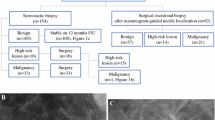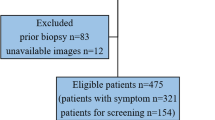Abstract
Background
The Japan Mammography Guidelines, referred to the American College of Radiology Breast Imaging Reporting and Data System (BI-RADS), are intended to standardize the terminology in mammographic reports and the assessment of findings and to recommend action to be taken. The Japan Mammography Guidelines have explicit guidelines for the categorization of microcalcifications. The purpose of this study was to assess the positive predictive value (PPV) of each categorization of microcalcifications according to the decision table proposed by the Japan Mammography Guidelines according to BI-RADS morphology and distribution parameters and the pathologic outcome.
Methods
A retrospective review was performed of 101 non-palpable screening mammography-detected microcalcification lesions without mass that had stereotactic vacuum-assisted breast biopsy (SVAB). This study was approved by our institutional review board, and informed consent was obtained for all SVAB. We classified microcalcification lesions according to the decision table. Histological findings were reviewed.
Results
In calcification morphology, all 32 punctate morphology microcalcifications, regardless of distribution, were benign (100%), whereas 25% (9/36) amorphous morphology microcalcifications, 67% (14/21) pleomorphic morphology microcalcifications and 92% (11/12) linear morphology microcalcifications were malignant. For calcification distribution, 28% (15/55) cluster distribution microcalcifications, 40% (17/43) segmental distribution microcalcifications and 67% (2/3) linear distribution microcalcifications were malignant. Features with high positive PPV showed segmental or linear distribution of linear morphology (100%, respectively), segmental distribution of pleomorphic morphology (100%) and cluster distribution of linear morphology (80%). The PPV for cluster punctate, cluster amorphous, cluster pleomorphic and cluster linear microcalcifications was 0, 21, 50 and 80%, respectively. The PPV for segmental punctate, segmental amorphous, segmental pleomorphic and segmental linear microcalcifications was 0, 27, 100 and 80%, respectively. The PPV for linear amorphous and linear linear microcalcifications was 50 and 100%.
Conclusions
The decision table proposed by the Japan Mammography Guidelines according to BI-RADS morphology and distribution parameters is useful, but continued development of the decision table to improve standardization in mammographic interpretation is needed.
Similar content being viewed by others
Abbreviations
- PPV:
-
Positive predictive value
- SVAB:
-
Stereotactic vacuum-assisted breast biopsy
- DCIS:
-
Ductal carcinoma in situ
- BI-RADS:
-
Breast imaging reporting and data system
- US:
-
Ultrasonography
- ADH:
-
Atypical ductal hyperplasia
- ALH:
-
Atypical lobular hyperplasia
References
Morrow M, Schnitt SJ, Harris JR. Ductal carcinoma in situ and microinvasive carcinoma. In: Harris JR, editor. Disease of the breast. 2nd edn. Philadelphia: Lippincott Williams and Wilkins; 2000. p. 383–401.
Bassett LW. Mammographic analysis of calcifications. Radiol Clin North Am. 1992;30:93–105.
The Committee of Mammography Guideline (Japan Radiological Society, Japanese Society of Radiological Technology): Mammography Guideline 2nd ed. Igaku Syoin, Tokyo, 2004 (in Japanese).
American College of Radiology. Breast imaging reporting and data system (BI-RADS). 4th ed. In: Reston VA, editor. American College of Radiology, 2003.
Pijnappel RM, Peeters PH, Hendriks JH, Mali WP. Reproducibility of mammographic classifications for non-palpable suspect lesions with microcalcifications. Br J Radiol. 2004;77:312–4.
Fondrinier E, Lorimier G, Guerin-Boblet V, Bertrand AF, Mayras C, Dauver N. Breast microcalcifications: multivariate analysis of radiologic and clinical factors for carcinoma. World J Surg. 2002;26:290–6.
Rubin E. Six-month follow-up: an alternative view. Radiology. 1999;213:15–8.
Hall FM. Malignancy in BI-RADS category 3 mammographic lesions. Radiology. 2002;225:918–9.
Liberman L, Dershaw DD, Morris EA, Abramson AF, Thornton CM, Rosen PP. Clip placement after stereotactic vacuum-assisted breast biopsy. Radiology. 1997;205:417–22.
Berg WA, Arnoldus CL, Teferra E, Bhargavan M. Biopsy of amorphous breast calcifications: pathologic outcome and yield at stereotactic biopsy. Radiology. 2001;221:495–503.
Liberman L, Abramson AF, Squires FB, Glassman JR, Morris EA, Dershaw DD. The breast imaging reporting and data system: positive predictive value of mammographic features and final assessment categories. AJR Am J Roentgenol. 1998;171:35–40.
Soo MS, Rosen EL, Xia JQ, Ghate S, Baker JA. Computer-aided detection of amorphous calcifications. AJR Am J Roentgenol. 2005;184:887–92.
Sickles EA. Periodic mammographic follow-up of probably benign lesions: results in 3,184 consecutive cases. Radiology. 1991;179:463–8.
D’Orsi CJ. The American College of Radiology mammography lexicon: an initial attempt to standardize terminology. AJR Am J Roentgenol. 1996;166:779–80.
Orel SG, Kay N, Reynolds C, Sullivan DC. BI-RADS categorization as a predictor of malignancy. Radiology. 1999;211:845–50.
Berg WA, Campassi C, Langenberg P, Sexton MJ. Breast imaging reporting and data system: inter- and intraobserver variability in feature analysis and final assessment. AJR Am J Roentgenol. 2000;174:1769–77.
Stomper PC, Connolly JL. Ductal carcinoma in situ of the breast: correlation between mammographic and tumor subtype. AJR Am J Roentgenol. 1992;159:483–5.
Evans A, Pinder S, Wilson R et al. Ductal carcinoma in situ of the breast: correlation between mammographic and pathologic findings. AJR Am J Roentgenol. 1994;162:1307–11.
Kettritz U, Rotter K, Schreer I et al. Stereotactic vacuum-assisted breast biopsy in 2,874 patients. Cancer. 2004;100:245–51.
Mendez A, Cabanillas F, Echenique M, Malekshamran K, Perez I, Ramos E. Evaluation of breast imaging reporting and data system category 3 mammograms and the use of stereotactic vacuum-assisted breast biopsy in a nonacademic community practice. Cancer. 2004;100:710–4.
Mendez A, Cabanillas F, Echenique M, Malekshamran K, Perez I, Ramos E. Mammographic features and correlation with biopsy findings using 11-gauge stereotactic vacuum-assisted breast biopsy (SVABB). Ann Oncol. 2003;15:450–4.
Uematsu T, Yuen S, Kasami M, Uchida Y. Dynamic contrast-enhanced MR imaging in screening detected microcalcification lesions of the breast: is there any value? Breast Cancer Res Treat. 2007;103:269–81.
Author information
Authors and Affiliations
Corresponding author
About this article
Cite this article
Uematsu, T., Kasami, M. & Yuen, S. Usefulness and limitations of the Japan Mammography Guidelines for the categorization of microcalcifications. Breast Cancer 15, 291–297 (2008). https://doi.org/10.1007/s12282-008-0033-4
Received:
Accepted:
Published:
Issue Date:
DOI: https://doi.org/10.1007/s12282-008-0033-4




